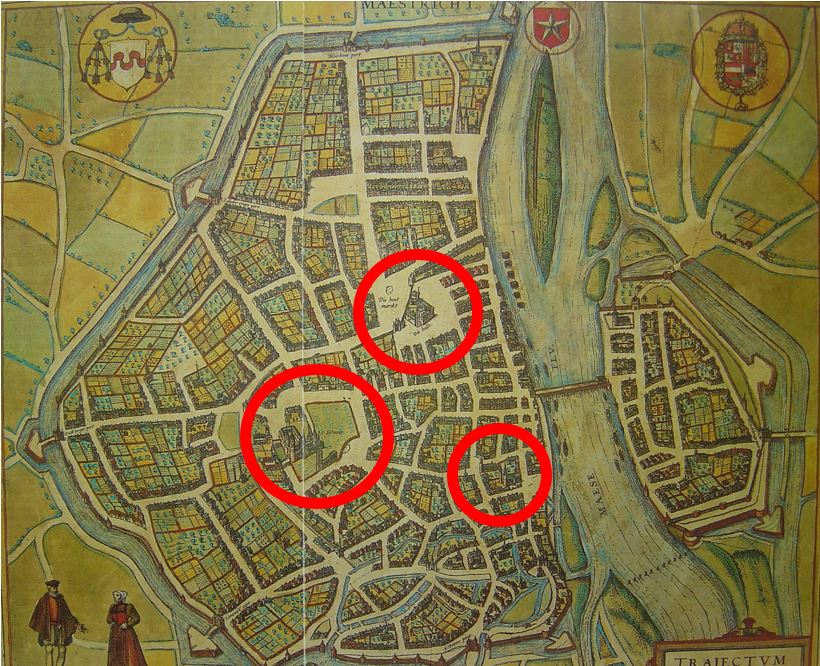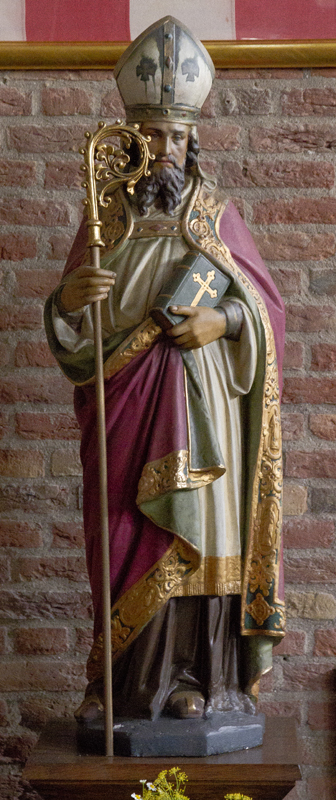
 |
| Fig. 21: Maastricht has three public squares: Vrijthof, Markt and Onze Lieve Vrouweplein. Plan with the situation as in 1580 |
Maastricht is a city with three squares in the city center, which is unusually high for such a small city. But they are squares with a relevant origin. Two squares are linked to churches and immunities. The third square is linked to the market. The two 'religious' squares are connected to the dual lordship of Maastricht, also known as 'condominium'. The exact origin of this dual lordship is still shrouded in the mists of history, but it certainly has to do with the two oldest churches in Maastricht, namely the predecessors of the current Saint Servatius Church (on the Vrijthof) and Church of Our Lady (at the Onze Lieve Vrouweplein). The existence of this dual lordship is recorded in the Alde Caerte (Old Charter) from 1284, but it actually dates from many centuries earlier. It’s existence continued until the French put an end to it in 1795. We also call this dual lordship period the 'ancien regime'.
 |
| Fig. 22: Image of the holy bishop Lambertus of Maastricht, who gave his name to the Lambertians, the “Liègeois” inhabitants of Maastricht |
The core of the dual lordship is formed by the two 'families' that lived in Maastricht: the Lambertians (the bishops' men) and the Servatians (the dukes' men). They weren't biological families, but groups or "clans" you belonged to. It was through the maternal connection that determined which group you belonged to. Newcomers to the city were automatically counted among the Servatians. The Lambertians were the people who were subservient to the Liègeois prince-bishop, who had its seat in the old Roman castellum, with the first episcopal church presumably under the current Church of Our Lady. The oldest mention of a Maria church dates from 694 AD, but this first church is probably older. The Servatians were the people who were subservient to the Church of Saint Servatius. The oldest phase of this church is a funerary chapel or 'eigenkerk' (a family church in which people were buried), founded by bishop Monulfus, on the site of the grave of the legendary predecessor bishop Servatius, who is said to have been buried in the ancient Roman cemetery west of the settlement from that time, around 450 CE. The oldest chapel dates from ca. 560-580 CE. In later years, a monastery and an abbey were built and the church was enlarged many times. Due to the many relics in the Servatius Church, it became an important place for pilgrims and was therefore very rich. The Carolingian ruling family saw this church as their personal property and it passed from hand to hand over the centuries. From Carolingian dependency to imperial Ottonian dependency, to immediate subject to the later German emperors and then subject to the guardianship of the dukes of Brabant and their heirs, namely the dukes of Burgundy, the kings of Spain and from 1632 the States of Holland. However, in fact, the Saint Servatius Church and chapter were only subject to the pope and were therefore actually autonomous, since the pope resided in Italy. The Church of Our Lady was also subject only to this pope and was therefore also actually autonomous.
Reference:
Ubachs, P.J.H., & I.M.H. Evers, Historische Encyclopedie Maastricht, Zutphen 2005.